Pros
Cons
Tour
The HFI-2200 headphones are predominantly brown, with dark orange cloth covering its various pads. The back of the ear cups are silver with branding. There are some slits cut around the silver part, giving these headphones a semi-open back. The cups are attached to the band at little cylindrical logs that are branded as left and right. These logs also allow for the cups to move around.
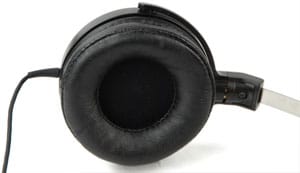
The padding is slightly triangular, with more padding toward the outside edge and less towards the inside.
The ear cups can tilt and rotate in a full 360. They can also be folded up to make for a more condensed package if you have to move them from place to place.
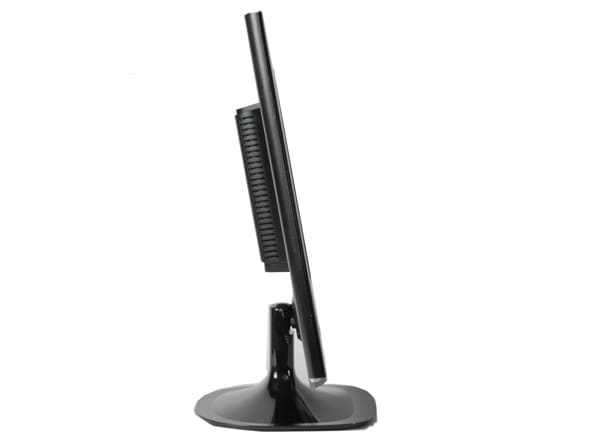
The left ear cup has a port for the cable and features threading for its screw-in cable.
In the Box
{{section_header}}{{section.name}}{{/section_header}}
In the box you'll find a software CD, a pouch, a 1/4-inch adapter, and a coil of cord. You'll also find the HFI-2200 headphones.
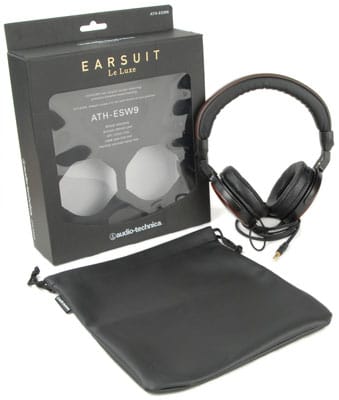
Durability
{{section_header}}{{section.name}}{{/section_header}}
Overall, the Ultrasone HFI-2200s don't exude durability because the plastic seems slightly on the cheap side. The cups can rotate full around the band and tilt back and forth, which have to potential to cause wear and tear damage over time (the same is true of the extendable band). The rotation and tilting movement have solid stops, however; we didn't feel we could easily break the cups off. The pads are cloth, which is generally good for durability: it will resist tears and piercing better than the faux-leather covering that's all the rage right now.
Aesthetics
{{section_header}}{{section.name}}{{/section_header}}
We asked around the office and the general consensus is these headphones look a bit 70s. Over-ear headphones have issues with being overly conspicuous to begin with; the orange and brown coloration doesn't particularly help. It's not that they're ugly, it's just that don't particularly fit in with the current headphone aesthetic. This aesthetic isn't over-the-top ridiculous, but it is a bit silly. If you wore these at the office, you'd probably hear your fair share of uninspired wise cracks. These are, however, more office-acceptable than the average pair of Skullcandy headphones.
Summary
{{section_header}}{{section.name}}{{/section_header}}
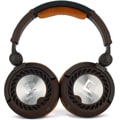
The Ultrasone HFI-2200 headphones are a set of home theater over-ears currently available for $300. Their aesthetic is a bit different from the usual monochrome of today's headphones, but if you want under-stated and different, the HFI-2200s will meet your needs. The HFI-2200 headphones also have an interesting trick: they can fold up into themselves. This is great to minimize their size for travel, and also for DJs who want to mix with one ear.
Frequency Response
{{section_header}}{{section.name}}{{/section_header}}
The HFI-2200 headphones had a pretty good frequency response for the most part, but the high end is dramatically under-emphasized. Things to look out far are long, sharp slopes, either up or down. Such features indicate a large gain or drop in decibel level over a small frequency range. That means an instrument could sound muted at times and normal at others, depending on what note its playing. In this case, as a sound approaches the high end, it will quickly decrease in volume for a bit, then spring back to normal.
Aside from the odd behavior towards the right side of the graph, however, the HFI-2200 performed rather well. The bass receives a bit of a boost, which anyone would notice the second they put these headphones on. We were surprised to see the mid-tones so evenly emphasized, since the bass seemed so boomy. The fallibility of our human ears is exactly why we use HATS and its robot ears.

The HFI-2200's response curve looked a lot like the Grado SR60s. In both, the bass is slightly emphasized, the mid-section is a bit choppy, and there's a bit of a drop off towards the high end. Unfortunately for the HFI-2200s, however, the drop off occurs within our scoring limits. The Pioneer SE-A1000 headphones also had a bit of a downward slope at the high end, but again, the valley came in the really high end. The Sennheiser HD 555s have a weaker bass (probably due to their open-backed design) and also have some under-emphasized frequencies towards the higher end, but they response never strays quite as far away as it does on the HFI-2200s. The same goes for the iGrados. The QC2s' graph looks like it has the flu. It's under-emphasized, erratic, and the HFI-2200 looks great in comparison.
In terms of all headphones, the HFI-2200s are just slightly below the current average score of 4.08. Not bad, but certainly not great.
Distortion
{{section_header}}{{section.name}}{{/section_header}}
Overall, there wasn't much distortion on the HFI-2200s. Towards the lower end, there were some issues, with the right channel almost hitting 2% distortion. Once the frequency climbed out of the realm of bass, however, distortion leveled off. There was a small bump towards the high-middle frequencies, but other than that the HFI-2200s did all right.
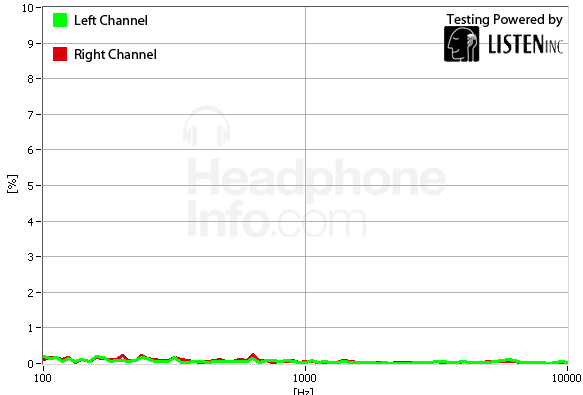
Other than the Sennheisers, which had virtually no distortion (towards the extreme low end the graph gets choppy, but we've since stopped scoring below 100 Hz), most headphones tend to score around what the HFI-2200s did. While a picky audiophile might demand better performance, the HFI-2200s should be fine for most consumers.
Tracking
{{section_header}}{{section.name}}{{/section_header}}
For the overwhelming majority of the graph, the HFI-2200 was just within a few decibels of even-handed playback. Once it got towards the high-end, however, the tracking gets a bit erratic. This is normal behavior, however. Really, we don't have any complaints. Unless our pair of HFI-2200s was a fluke, you should never get the sensation that your playback is weighted towards the left or right.
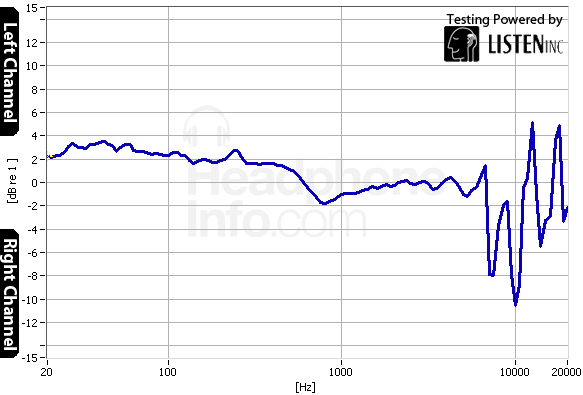
It's easy to see why a few of the headphones performed worse than the HFI-2200 on this test: the left part of the graph curves upward or downward, indicating it isn't on an even keel. The Pioneer SE-A1000s also have a flat line initially, but towards the end their spike is far more pronounced than anything the HFI-2200 shows.
Maximum Usable Volume
{{section_header}}{{section.name}}{{/section_header}}
The Ultrasone HFI-2200 headphones were capable of outputting 104.94 decibels. A good score would fall between closer to 120 decibels. Still, 104.94 decibels isn't a terrible score. Mainstream users who don't have to drown out a noisy bus commute should find this level adequate. If you are seriously hell-bent on ruining your hearing, sorry, but the HFI-2200s aren't the best option.
Isolation
{{section_header}}{{section.name}}{{/section_header}}
The HFI-2200 headphones did poorly on this test. We're guessing the main reason they weren't able to block out much noise was because cloth forms a very poor seal with skin. It leaves all sorts of nooks, crannies, and passageways that air and sound can pass through. Cloth-covered headphones are notoriously bad at keeping external sound out.

Compare any of the headphones' scores and graphs below to the QuietComfort 2s' score and graph. Don't even look at the active cancellation curve. See how much better the QC2s are at passive cancellation? They have a faux-leather padding, whereas the others all have cloth or foam padding. Of course, a poor seal isn't the only culprit here. The SR60s, iGrados, and HD 555s all have open or semi-open backs, so sound can just waft right through your headphones and into your ears.
Compared to other cloth-padded headphones, the HFI-2200s actually didn't do half bad. If you want isolation, however, cloth is not the way to go.
Leakage
{{section_header}}{{section.name}}{{/section_header}}
The HFI-2200 headphones tended to leak more sound that we'd like. We attribute this, again, to the cloth padding, and the poor seal cloth makes against skin. A weak seal means noise can easily escape from the miniature soundstage the cups create around your ears. If you're listening to music at a moderate level, someone next to you on the bus or train will be able to make it out. Forget about taking these to a library.
Short-Term Use
{{section_header}}{{section.name}}{{/section_header}}
We didn't think the HFI-2200 headphones were particularly comfortable. The padding on the band felt uncomfortably hard and the cup padding felt a bit itchy. While these headphones were more comfortable than, say, the iGrado headphones after six hours, they still weren't the best wear experience we've had. We tend to prefer faux-leather coverings to fuzzy cloth, since it itches less and provides a better seal.
Extended Use
{{section_header}}{{section.name}}{{/section_header}}
Over the course of six hours, we grew slightly more accustomed to the HFI-2200s. By the end of the session we still thought they were slightly uncomfortable -- the head padding still felt somewhat hard -- but not so uncomfortable we wouldn't want to wear them again. We recommend trying these on before you buy them, because if you happen to have a more sensitive head than we do, you might not like these headphones. If your head is made out of iron and muscle, then you might like these headphones just fine.
Cable Connectivity
{{section_header}}{{section.name}}{{/section_header}}
Until we make futuristic transforming headphones, over-ears will always be a bit awkward to lug around compared to in-ears. You can't ball them up and shove them into a pocket easily and they take up a lot of head real estate. In addition to the size issue, the cords of over-ears typically aren't made to be portable: they're thicker and often twice as long as in-ear cords. In this case the cord is just about 15-feet long, which is quite a substantial amount of cord to be lugging around in your pocket. The only saving grace for the HFI-2200s' portability is the ability to detatch the cord. Of course, this requires you to have your own audio cable, but it's better than having a giant knot of cord in your pocket.
If you really want portability, however, there are far better options out there for you. These options will probably isolate you better and leak less sound than the HFI-2200s will.
Customizability
{{section_header}}{{section.name}}{{/section_header}}
The only custom options you have with the HFI-2200s right out the box are band extension and cup rotation. These are basic customizability options. There aren't any bells or whistles included in the packaging that will alter the look of your headphones, such as face plates or different cup options. Very few headphones have good options for customization.
Portability
{{section_header}}{{section.name}}{{/section_header}}
Until we make futuristic transforming headphones, over-ears will always be a bit awkward to lug around compared to in-ears. You can't ball them up and shove them into a pocket easily and they take up a lot of head real estate. In addition to the size issue, the cords of over-ears typically aren't made to be portable: they're thicker and often twice as long as in-ear cords. In this case the cord is just about 15-feet long, which is quite a substantial amount of cord to be lugging around in your pocket. The only saving grace for the HFI-2200s' portability is the ability to detach the cord. Of course, this requires you to have your own audio cable, but it's better than having a giant knot of cord in your pocket.
If you really want portability, however, there are far better options out there for you. These options will probably isolate you better and leak less sound than the HFI-2200s will.

Maintenance
{{section_header}}{{section.name}}{{/section_header}}
While you can't outright disassemble the HFI-2200 headphones, you can get right down to the sound element in case you want to clean it, replace a part, or re-solder it. First you have to remove the cup padding. This should reveal the 'MU Metal bufferboard,' which Ultrasone says reduces field emissions.
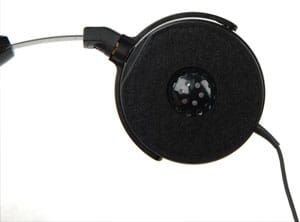
Once you take off the pad, there isn't much more you can do.
The next step -- assuming you're not afraid of field emissions -- is to unscrew the bufferboard. The screws accept a regular phillips screwdriver, so no need for specialized equipment. Some of the screws are red herrings that don't actually hold anything in place, but we didn't know this beforehand so we foolishly unscrewed them all. There are two lengths of screws, so you should remember to mark what you're taking from where.

Once the screws are out, lo! Some wires and computer chips! The driver is actually attached to the bufferboard; unless you've got a tiny crowbar, a soldering iron, and a callous disregard for headphone privacy, you'll have to admire the driver from afar. This is actually a bit annoying, since you'll have to rely on canned air to clean it out through the holes in the bufferboard. Overall, however, we were impressed with the access we were given to the headphones' internals.
Other Features
{{section_header}}{{section.name}}{{/section_header}}
S-Logic Natural Surround Sound
We're guessing this added feature is partially responsible for the boomy bass. The box had this to say (and yes, those typos were on the box, faithfully reproduced here):
'With normal headphones you have the impression, that the music is being played in your head. ULTRASONE headphones with the patented S-Logic (TM) Naturlal Surround Sound give you a natural 3-dimansional sound."
We certainly didn't hear anything out of the ordinary, except maybe for boomy (slightly echo-y?) bass. Maybe we were just impervious to the psychoacoustics, but we didn't think this feature added anything to our listening experience.
Battery
These headphones aren't dependent on a battery. This allows them to be slightly more portable than a battery-reliant model and is also far less of a hassle.
Value
{{section_header}}{{section.name}}{{/section_header}}
We think the HFI-2200s are a bit overpriced for what they offer. They don't have the best audio quality and aren't particularly comfortable. At $299, you should expect your headphones to have at least better than average audio quality. If they don't, then they'd better be otherwise luxurious. Unfortunately, neither is the case for the HFI-2200s. You can get better for your money.
Conclusion
{{section_header}}{{section.name}}{{/section_header}}
The HFI-2200 headphones would have been an okay entry-level set of headphones. They don't have the best audio quality, and they also aren't that comfortable, but they aren't, by any means, terrible. Unfortunately for them, their cost is terrible. At the $300 price point, you're towards the higher side of mid-range headphones. Unfortunately, the HFI-2200 headphones can't compete with other headphones in this category. The Bose QC2s, which are a bit overpriced to begin with, are a better value than the HFI-2200 headphones. Sadly, the Ultrasone HFI-2200 headphones seem to suffer from a price typo: if they cost 1/3 what they do, they could've duked it out with the Grado SR60s on 'Best Headphones Under $100' lists. At their current price bracket, however, they're simply outclassed by their peers.
Meet the tester
Mark Brezinski works on the Home Team, reviewing refrigerators, minifridges, dishwashers, washing machines, dryers, air conditioners, air purifiers, and fans.
Checking our work.
Our team is here to help you buy the best stuff and love what you own. Our writers, editors, and experts obsess over the products we cover to make sure you're confident and satisfied. Have a different opinion about something we recommend? Email us and we'll compare notes.
Shoot us an email